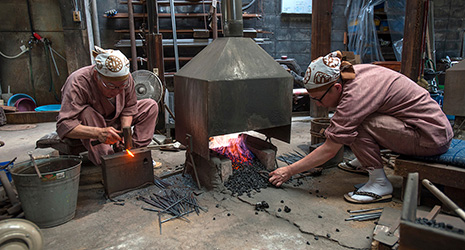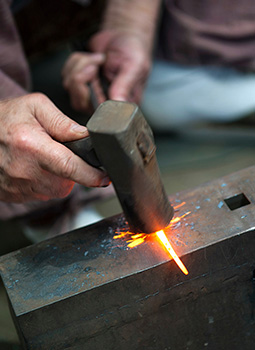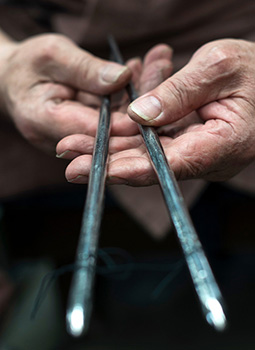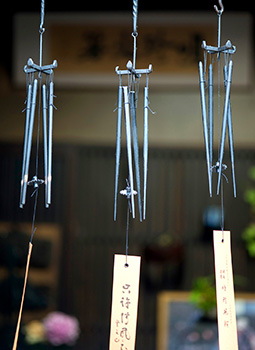Home > Highlighting JAPAN > Highlighting Japan July 2017 > Evolving Traditions
Highlighting JAPAN


Clarity of Purpose
Munemichi Myochin’s family has been in the iron forging business for over 850 years. The company’s output has changed with the times, but one characteristic of its work has remained constant.
The easiest way to find Munemichi Myochin’s inconspicuous workshop is to walk around the Idei district to the northeast of historic Himeji Castle and open your ears.
If you cannot hear the repeated clank of hammer beating metal, you will almost certainly catch the delicate tones of the product that Munemichi and his third son, Keizo, craft at the Myochin family business in Himeji City, Hyogo Prefecture.
By themselves those creations, known as “hibashi furin,” appear modest, resembling long, blunt nails or impracticably weighty chopsticks.
But the timbre of these unique cast iron furin, or wind chimes, has won admirers far and wide, among them some giants of the music world, including Stevie Wonder and electronica pioneer Isao Tomita.
Indeed, Tomita was so taken with the chimes that until his death in 2016, he paid visits to the Myochin workshop for over forty years. “Tomita-sensei told me that his goal was to make music like these wind chimes,” says Munemichi. “I felt extremely humbled that such a great man would say that.”
The story of the evolution of the wind chimes is as unusual as the wind chimes themselves and if it was not entirely by chance that the Myochins started manufacturing them, it was certainly out of necessity.
“Hibashi” actually translates as “fire chopsticks,” a reference to the items that the Myochin family formerly crafted since the 1860s.
“Even when I was a child, we used charcoal-burning braziers for heating and we made hibashi to pick up the hot coals,” says Munemichi, who started working under his father fifty-seven years ago. “Then, in the 1960s oil heaters came in and demand for hibashi petered out. It was really a case of do or die.”
This wasn’t the first time the Myochins faced such a dilemma. Munemichi’s ancestors have been in the iron forging business for over 850 years, formerly making suits of armor for samurai warriors and their daimyo (feudal lord). However, Japan’s Meiji Restoration (1868) saw the abolishment of feudal fiefdoms and within a matter of years demand for armor ceased.
Consequently, the Myochins sought a new line of business and, keen to continue the forging technologies that the family had cultivated, they applied it to the manufacture of hibashi, metal tongs.
The more recent company reinvention to producing wind chimes once more proved the old adage that necessity is the mother of invention.
“Well-forged steel produces a nice sound when struck and in the Taisho period (1912–1926) there was even a novel that mentioned the lovely timbre of the hibashi,” explains Munemichi’s second son, Munehiro, who makes katana, traditional Japanese swords. “So in order to survive we readjusted our business objective once more. Yet, regardless which direction we have taken, sound has been an important component for our company.”
Creating wind chimes that achieve that sound is no easy task.
“With these chimes, a nice shape alone is not enough,” Munemichi explains. “The metal has to be at the optimum temperature when you forge it to ensure that the best sound quality can be achieved. I judge that temperature entirely by color. When the metal turns to a whitish hue, that’s when we remove it from the [charcoal-fueled] furnace and start the forging. That’s the secret of the sound. If you work the metal when the temperature is too low you end up with a dull clank.”
To produce an acceptable sound takes around seven or eight years of intensive work, he adds.
Evidence of that experience can be seen on the broad, slightly angled face of the hammer head, which has a single, narrow line branded across it indicating the precision of his blows as they strike the hibashi furin he forges.
“This is extremely tough work and I was born into a family of modest means,” says Munemichi, who together with Keizo makes around 2,000 sets of the wind chimes a year, including those recently added to the family’s product range that are made from titanium. “But I have never once thought about packing in. Even now at 75, sitting here and hammering away gives me immense pleasure.”
Maintaining traditional techniques but evolving them with the times, the Myochin family’s business approach is typical of Japan’s long-established companies.
© 2009 Cabinet Office, Government of Japan









